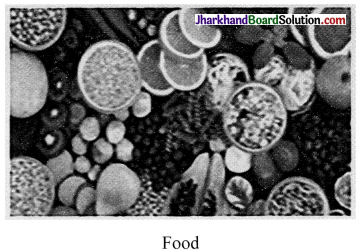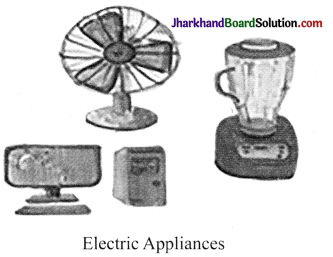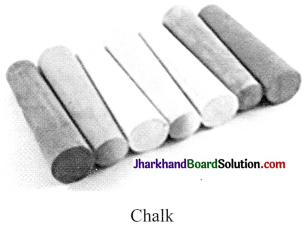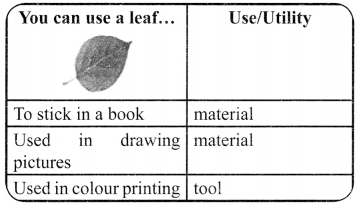JAC Board Class 8th Social Science Solutions Geography Chapter 1 Resources
JAC Class 8th Geography Resources InText Questions and Answers
Question 1.
List out five resources you use in your home and five you use in your classroom.
Answer:
Five resources we use in our home are:
Question 2.
Circle those resources from Amnia’s list that are regarded as having no commercial value.





Five resources we use in our classroom are:





Amma’s List
- Cotton cloth
- Iron ore
- Intelligence
- Medicinal plants
- Medical knowledge
- Coal deposits
- Beautiful scenery
- Agricultural land
- Clean environment
- Old folk songs
- Good weather
- Resourcefulness
- A good singing voice
- Grandmother’s home remedies
- Affection from friends and family
Answer:
Student need to do it on their own.
Question 3.
Think of a few renewable resources and mention how their stock may get affected by overuse.
Answer:
Some of the renewable resources that regenerate over-time such as trees, crops, wind, solar energy and water. Their stock may get affected by overuse or over utilisation because of certain reasons such as land degradation, deforestations, pollution, etc. Rivers are drying up, air becomes more polluted due to smoke from vehicles and industries. Trees are cut down to make more buildings, etc.
![]()
Question 4.
Make a list of five human made resources that you can observe around you.
Answer:
A list of five human made resources that we observe around are:
- Phones
- Buildings
- Vehicles
- Aeroplanes
- Roads
JAC Class 8th Geography Resources Textbook Questions and Answers
Question 1.
Answer the following questions.
(i) Why are resources distributed unequally over the earth?
Answer:
The resources are distributed unequally over the earth because it is controlled by different factors. One of the factors is physical nature which includes climate, altitude, terrain which vary from place to place.
(ii) What is resource conservation?
Answer:
Resource conservation is to use the resources efficiently, carefully and properly and giving time to get renewed and to regenerate the resource so that it will be available for the coming generations.
(iii) Why are human resources important?
Answer:
Human resources are important because they can utilise the natural resources in a best possible way to generate more resources as they have an intelligent mind. Human resources also include technology and skills to find the suitable resource. Advantage and usefulness of resources can be best judged by human beings only.
(iv) What is sustainable development?
Answer:
Sustainable development is to use the resources in a balanced way so that we conserve it for the future generation and utilise it efficiently for our needs.
Tick the correct answer.
Question 2.
(i) Which one of the following does NOT make substance a resource?
(a) utility
(b) value
(c) quantity
Answer:
(c) quantity
(ii) Which one of the following is a human made resource?
(a) medicines to treat cancer
(b) spring water
(c) tropical forests
Answer:
(a) medicines to treat cancer
(iii) Complete the statement. Non-renewable resources are
(a) those which have limited stock
(b) made by human beings
(c) derived from non-living things
Answer:
(a) those which have limited stock
![]()
Question 3.
Activity:
“Rahiman paani raakhiye, Bin paani sab soon. Paani gaye na ubere Mod, manus, choon…” [Says Rahim, keep water, as without water there is nothing. Without water pearl, swan and dough cannot exist.] These lines were written by the poet Abdur Rahim Khankhana, one of the nine gems of Akbar’s court. What kind of resource is the poet referring to? Write in 100 words what would happen if this resource disappeared?
Answer:
The poet is referring to the water. If this resource disappear then we will face serious difficulties as water is one of the most invaluable and irreplaceable resource of life. Without water, we cannot survive and sustain. It serves many purposes such as to drink, to clean clothes and utensils and bath. For irrigation and farming, water is required very much. It is also used for cooking food. Water helps in generating electricity, industries and factories. Apart from human beings, animals, plants and trees also require water to sustain. Without water, the earth will become desert and no life will sustain. For Fun
Question 1.
Pretend that you live in the prehistoric times on a high windy plateau. What are the uses you and your friends could put the fast winds to? Can you call the wind a resource? Now imagine that you are living in the same place in the year 2138. Can you put the winds to any use? How? Can you explain why the wind is an important resource now?
Answer:
Wind has long been in use, since ancient time. It has been used for sailing boats, for navigation. Gradually wind mills were built to grind crops also to pump out water. Wind was regarded as a potential resource. However due to lack of technology it could not be harnessed completely. In 2138, we can surely see wind being used to the fullest as an actual resource. We have built wind turbines to generate electricity. We can see more and more wind turbines brings used in industrial areas, in agricultural farms to meet irrigation and electricity needs.
Question 2.
Pick up a stone, a leaf, a paper straw and a twig. Think of how you can use these as resources. See the example given below and get creative!


Answer:
Students can do the other two on their
JAC Class 8th Geography Resources Important Questions and Answers
Multiple Choice Questions
Question 1.
A substance is made a resource when it has………
(a) Value
(b) usability
(c) utility
(d) all of these
Answer:
(d) all of these
Question 2.
Value means
(a) worth
(b) deserves
(c) both ka’ and ‘b’
(d) neither ‘a’ nor ‘b’
Answer:
(c) both ka’ and ‘b’
Question 3.
Time and technology are two important factors that can change substances into .
(a) stock
(b) resource
(c) patent
(d)value
Answer:
(b) resource
![]()
Question 4.
Natural resources contains
(a) air
(b) wind
(c) water
(d) all of these
Answer:
(d) all of these
Question 5.
The distribution of natural resources depends on…….
(a) terrain
(b) altitude
(c) both ka’ and kb’
d. none of these
Answer:
(c) both ka’ and kb’
Question 6.
Non-renewable resource is…….
(a) natural gas
(b) solar energy
c. wind energy
d. soil
Answer:
a. natural gas
Question 7.
Water is a………
(a) non-renewable resource.
(b) renewable resource.
(c) either ‘a’ or ‘b’
(d) none of these
Answer:
(b) renewable resource.
Question 8.
Resources to conserved for…..
(a) future generations.
(b) present generations.
(c) not required to conserve.
(d) both ‘a’ and kb’
Answer:
(d) both ‘a’ and kb’
Question 9.
Human resource refers to the
(a) quantity
(c) mental ability
(b) physical ability
(d) all of these
Answer:
(d) all of these
![]()
Question 10.
Buildings, bridges are
(a) human-made.
(b) non-renewable.
(c) renewable resource.
(d) resource conservation.
Answer:
(a) human-made.
Very Short Answer Type Questions
Question 1.
Which value is associated with resources?
Answer:
Economic value is associated withresources.
Question 2.
What do you mean by patent?
Answer:
Patent means the full and unshared right over any idea or invention of any particular thing.
Question 3.
What are the different types of resource?
Answer:
The different types of resources are:
- Natural resources
- Human made resources
- Human resources
Question 4.
What do mean by natural resource?
Answer:
Natural resources are the resources which are drawn from nature, environment and used without much alterations and moderations.
Question 5.
Name the two natural resources.
Answer:
The two natural resources are:
- Renewable resource
- Non-renewable resource
Question 6.
Which resource has a limited stock? Answer: Non-renewable resource has a limited stock.
Question 7.
What do mean by human made resource?
Answer:
Human made resources are the resources which are generated and made by human beings.
Question 8.
Define human resource development.
Answer:
Human resource development means to improve the caliber, standard and quality of human expertise in order to make them more efficient and useful.
Short Answer Type Questions
Question 1.
Mention few concepts of Sustainable Development.
Answer:
Few concepts of Sustainable Development are:
- Respect and care for all forms of life.
- Improve the quality of human life.
- Conserve the earth’s vitality and diversity.
- Minimise the depletion of natural resources.
- Change personal attitude and practices toward the environment.
- Enable communities to care for their own environment.
Question 2.
What is the importance of time and technology in making a substance a resource?
Answer:
Two major and important factors are time and technology that can change substances into resources. Each invention opens new routes to many others. The invention of fire led to the practice of cooking and other processes while the invention of the wheel resulted in development of newer modes of transport. The technology to create electricity from water i.e., hydroelectricity has turned energy in fast flowing water into an important resource.
![]()
Question 3.
Our duty is to maintain and preserve the life support system that nature provides us. What are they?
Answer:
Our duty is to maintain and preserve the life support system that nature provides us. They are:
- All uses of renewable resources are maintained at a certain level.
- The varied range of life on the earth is conserved.
- The damage to natural environmental system is lessened and reduced.
Question 4.
Stock of certain renewable resources may get affected by overuse. How?
Answer:
If we don’t use certain renewable resources efficiently such as water, soil and forest, these can affect their stock. Though water seems to be an unlimited renewable resource but shortage and drying up of natural water sources is a major issue in many parts of the world nowadays.
Question 5.
Describe the term resource and how they are classified.
Answer:
Any object, substance or material that has utility or usability makes a resource. The substances which have certain values become a resource.
Resources are classified into three parts:
Natural Resources These resources are those which are taken from nature.
Human made Resources:
These resources are those which are made by the humans and used their skill and knowledge to make the things for their own use.
Human Resources:
These resources includes human beings who serves in many ways such as teachers, doctors, etc.
Long Answer Type Questions
Question 1.
Distinguish between natural resources and human made resources.
Answer:
| Natural Resources | Human Made Resources |
| Natural resources are the resources that are used from nature and used without much alteration and changes. | When humans use natural things to make something new that provides utility and value to our lives, it is called human-made resources. For instance, when we use metals, wood, cement, sand, and solar energy to make buildings, machinery, |
| Most of these resources can be used directly as they are free gifts of nature. | vehicles, bridges, roads, etc. they become man-made resources. |
| Natural resources are the air we breathe, the water in our rivers and lakes, the soils minerals. | Natural substances become resources only when their original form has been changed or modified to use such as iron is extracted from iron ore. |